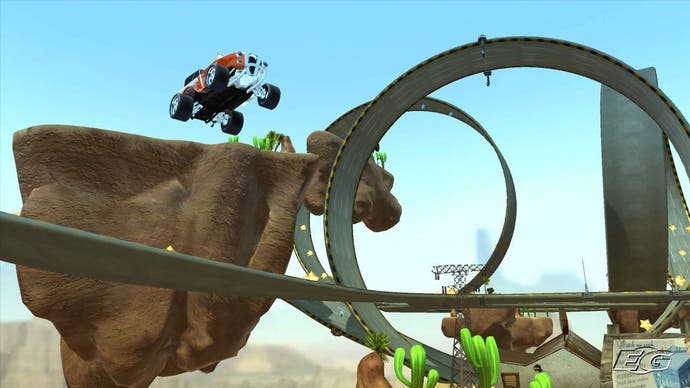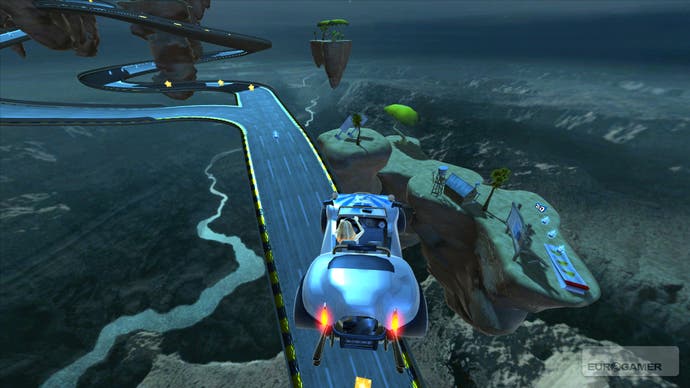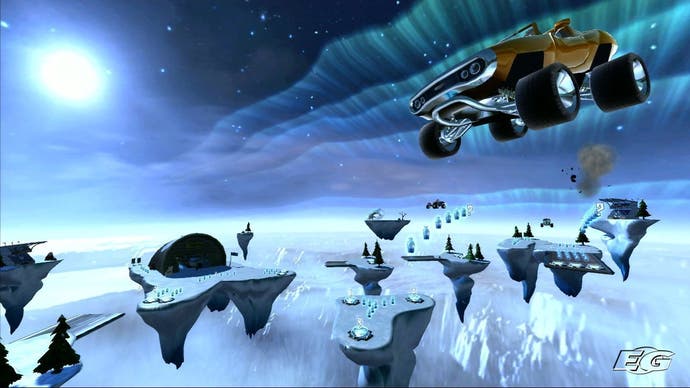GripShift
Race to wiiiiiiin!
A few years ago, a friend of mine gave a popular Japanese videogame 8/10 in a British magazine. I like it more than that, and I was surprised by the response, so (it occurs to me you're going to like this story) I asked what stopped it getting a higher score. The answer came back: "I wasn't sure if people would like it the way I do."
Sometimes, the emphasis is definitely on "way". EG old boy Ronan didn't like the sequel to Baldur's Gate: Dark Alliance as much as he thought he would because it wasn't as good for "loot racing". Kristan loves adventure games like Fahrenheit, but thinks action bits should go take a running jump (as, I suppose, is their wont).
Which bring me to GripShift, because it is so completely made for me. It's a racing game where each circuit is suspended in the sky and has three objectives: get round as quickly as possible, collect stars and get round as quickly as possible, and collect a "GS" token and get round as quickly as possible. As a straightforward racer, it's a bit floaty and derivative. But it's not really about that. It's not really even about racing against other people directly; it's about taking advantage of the abstract physics to uncover shortcuts; and it's about shaving your times until they're bald enough to top global leaderboards.
We first encountered it on the PSP, where it didn't quite gel. Individual goals were relatively easy to secure, and there was no imperative for self-improvement once you had conquered them - no added benefit to achieving more than one objective as part of the same attempt, and only the unlikely prospect of being active enough to regularly compare times with a friend to sustain it. But, with the advent of PlayStation 3's online service (for which GripShift joined the launch line-up), things changed. Being able to compete for the best times against international opposition made a good game very good.

The same, thankfully, is true on Xbox Live Arcade. There are over 100 Challenge levels to tackle, tailored to various difficulty levels, and even the very easiest will be fought over. Even the very first, actually, where achieving the best time is about accelerating perfectly off the start, covering the ground to the first small hill quickly and then managing your speed so that you can slip between a pair of crash barriers on the left side of the track and descend toward the finish line below, pitching forward and flooring the gas pedal in flight to glide through the finish gate.
Unless that's not the best way to do it, of course, which is another part of the game's charm - each level has been designed, redesigned, tweaked, polished and road-tested so thoroughly that finding the most efficient routes is a battle not only against other players but also the designers. You develop and test new theories as you tackle a particular goal (perhaps I can use the bounce pad to fly round the back of the Woolly Mammoth encased in ice, thus getting better momentum when I aim for the ramp on the left) and sometimes they work (I wonder if I can cut that corner by flicking myself up off the upward slant of a sprouting crash barrier and using the pitch control and nitrous button to power myself through the goal) and sometimes they don't (aha, they've put a giant icicle in my way).
Asking you to do three different things, which often changes the way you approach the level significantly, also has its benefits in this area - giving you another perspective on your activities up to that point. Their separation felt like a design flaw on the PSP, but in the context of global leaderboards it's a way to invest yourself in a level without having to explore it for no tangible gain. As soon as you spot it, pull up the menu and restart and you're back on the grid in a split second.

One difference between this and the PlayStation Network version is that there are no longer individual leaderboards for each discipline on each track. So while on PS3 you could compete to be fastest on any individual track even if you had no hope of being fastest to retrieve all the spinning stars, on Xbox Live Arcade your overall position on the leaderboard is dictated by some algorithmic determination of your average performance across all three objectives. In other words, you can still try and simply be the best at being fast, but if you're to be king of the world you will probably have to be best at two out of three things, or at least significantly better at one and only close behind on the other two.
And I've enjoyed that change, actually. If each individual discipline were decidedly different (say, running compared to clapping), it might be easier to complain about their newfound co-dependency, but the truth is that they are similar enough that the satisfaction of pursuing one is true of the others. And thus the measure of skill is probably more astute.
But you can see why GripShift is a "the way I like it", can't you? It can't escape this. There are 25 tracks used for a series of racing modes (challenges are one-on-one races where you also collect stars, time attacks are time attacks, single races are single races, championships are championships), and these incorporate a number of fairly standard kart-racing-style power-ups (homing projectile weapons, oil-slicks, mines, shields, etc.), but, while there's an increase in speed (and difficulty, obviously) from difficulty level to difficulty level, there are better competitive arcade racing games around.
The new deathmatch mode, added for Xbox Live Arcade, however, takes these basic kart-racing battle mode elements and combines them with the floaty physics and absurd aerial nitrous manoeuvring and suddenly flourishes. You can stack up to three power-ups in your arsenal and switch between them with X, and then fire with B as you're jetting around complicated networks of islands and racetrack suspended above a perilous drop. Maintaining sure footing (wheeling?) varies in difficulty between battlegrounds, and combines well with a diverse range of track elements to create distinct scenarios. The fast pace and cycle of death and respawning has you laughing manically one minute and cursing the next, but always dead by your own clumsiness rather than the game's design, and always eager to get back in the fray, particularly as you retain stored power-ups.

It's an interesting enough game mode on its own, and perfectly capable of maintaining your interest across the multiple tracks, weapon-sets and with varying numbers of players. It would be interesting to watch how it was received away from its host game. As it is, it's a welcome footnote to an already wicked game.
I wasn't even looking forward to it, really. I just wanted to play more GripShift. But with each iteration of the formula Sidhe has proven itself a developer worth watching. Whether you're simply racing to top your friends' scores, as you would in any Xbox Live Arcade games, or you're racing for the very top, this is an unbelievably addictive physics puzzle game with its roots in TrackMania, Mercury and games of their ilk and arguably the beating of most of them. A facility to save your replays would have made it better, as some of the things you'll need to do to get yourself to the top of the leaderboards are audacious enough that you will want to preserve them, but it's a forgivable oversight. Providing you like it the way I do. Hopefully the above will give you a sufficient clue as to whether that's the case.


